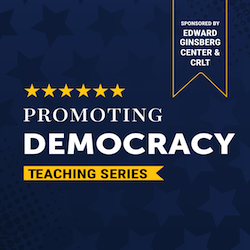You may have heard about the recent trending on Twitter of #BBUM, a series of tweets featuring brief student perspectives on "being black at Michigan." Some of the statements are about numbers while others are about interactions: being the "only one" in a class, or being expected to be a spokesperson.
Knowing such experiences and dynamics are present in U-M classrooms, what can instructors do?
Right now...
You might want to have discussions with your own students to find out how they experience what U-M students and alumni are tweeting about. Reflecting on CRLT's Guidelines for handling controversial topics can be valuable, whether you plan to bring up the topic or just want to be ready if your students do.
In the long run...
No matter your discipline, there are many strategies you can use to cultivate inclusive learning environments in your classrooms. These include framing your classroom dynamics. You can do this by:
- Explicitly stating how important every student’s perspective is in your class.
- Establishing ground rules for mutual respect. You can find examples here.
- Identifying as a learning goal for your class that students become better able to engage with views, experiences, and problem-solving approaches different from their own.
- Recapping: At the end of a class session, asking students to write down something they learned from another student in addition to what they learned from you and the assigned material.
Teachers in any field can also structure student interactions to be positive and productive. More formal structures may seem less engaging or friendly than informal exchanges, but providing clear shape and direction for classroom interactions can lead to greater inclusion and more active engagement in the conversation. Some simple strategies include:
- Using a brief in-class writing assignment, even in a lecture setting, instead of asking for a volunteer to raise a hand. This approach engages all students, giving everyone a chance to think, articulate their thoughts, and have something to say. It changes the default student position from 'wait for another student to speak' to 'think about the question the teacher posed.'
- Using a queue for class discussion, noting who has volunteered and naming the sequence in which you will call on them. Handraising lets more people participate than the informal style of letting the most assertive students jump in.
- Using pairs or small groups as opportunities for students to exchange their views on a question, problem, experience -- and address one another by name.
- Posing different types of questions -- including questions that draw on various background knowledge and experience -- and asking students to exchange views on how they know what they know.
- For small group work: assigning groups yourself, using small groups of 3-4 students, identifying a structure and process that will engage everyone, and -- for longer term projects -- creating rubrics and peer evaluation structures to help build skills for collaboration. For more on using student groups effectively, see CRLT's Occasional Paper on Student Teams.
You can also click on the "Inclusive Teaching" tag below for more resources on creating classroom environments where all students feel welcome and fully supported in their learning.
- Log in to post comments
- 262 views






